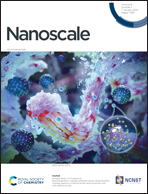Two dimensional materials are non-nanotoxic and biocompatible towards cyclotides: evidence from classical molecular dynamics simulations†
Abstract
Cyclotides are backbone-cyclized peptides of plant origin enriched with disulfide bonds, having exceptional stability towards thermal denaturation and proteolytic degradation. They have a plethora of activities like antibacterial, antifungal, anti-tumor and anti-HIV properties predominantly owing to their selective interaction with certain phospholipids, thereby leading to the disruption of cellular membranes. On the other hand, low-dimensional materials like graphene and hexagonal boron nitride (h-BN) are also known to show membrane-proliferating activities through lipid extraction. A plausible and more effective antibacterial, anti-tumor and antifungal agent would be a composite of these 2D materials and cyclotides, provided the structures of the peptides remain unperturbed upon adsorption and interaction. In this study, classical molecular dynamics simulations are performed to understand the nature of adsorption of cyclotides belonging to different families on graphene and h-BN and analyze the resulting structural changes. It is revealed that, due to their exceptional structural stability, cyclotides maintain their structural integrity upon adsorption on the 2D materials. In addition, the aggregated states of the cyclotides, which are ubiquitous in plant organs, are also not disrupted upon adsorption. Extensive free energy calculations show that the adsorption strength of the cyclotides is moderate in comparison to those of other similar-sized biomolecules, and the larger the size of the aggregates, the weaker the binding of individual peptides with the 2D materials, thereby leading to their lower release times from the materials. It is predicted that graphene and h-BN may safely be used for the preparation of composites with cyclotides, which in turn may be envisaged to be probable candidates for manufacturing next-generation bionano agents for agricultural, antibacterial and therapeutic applications.



 Please wait while we load your content...
Please wait while we load your content...